Master Lock Contractor Boxes
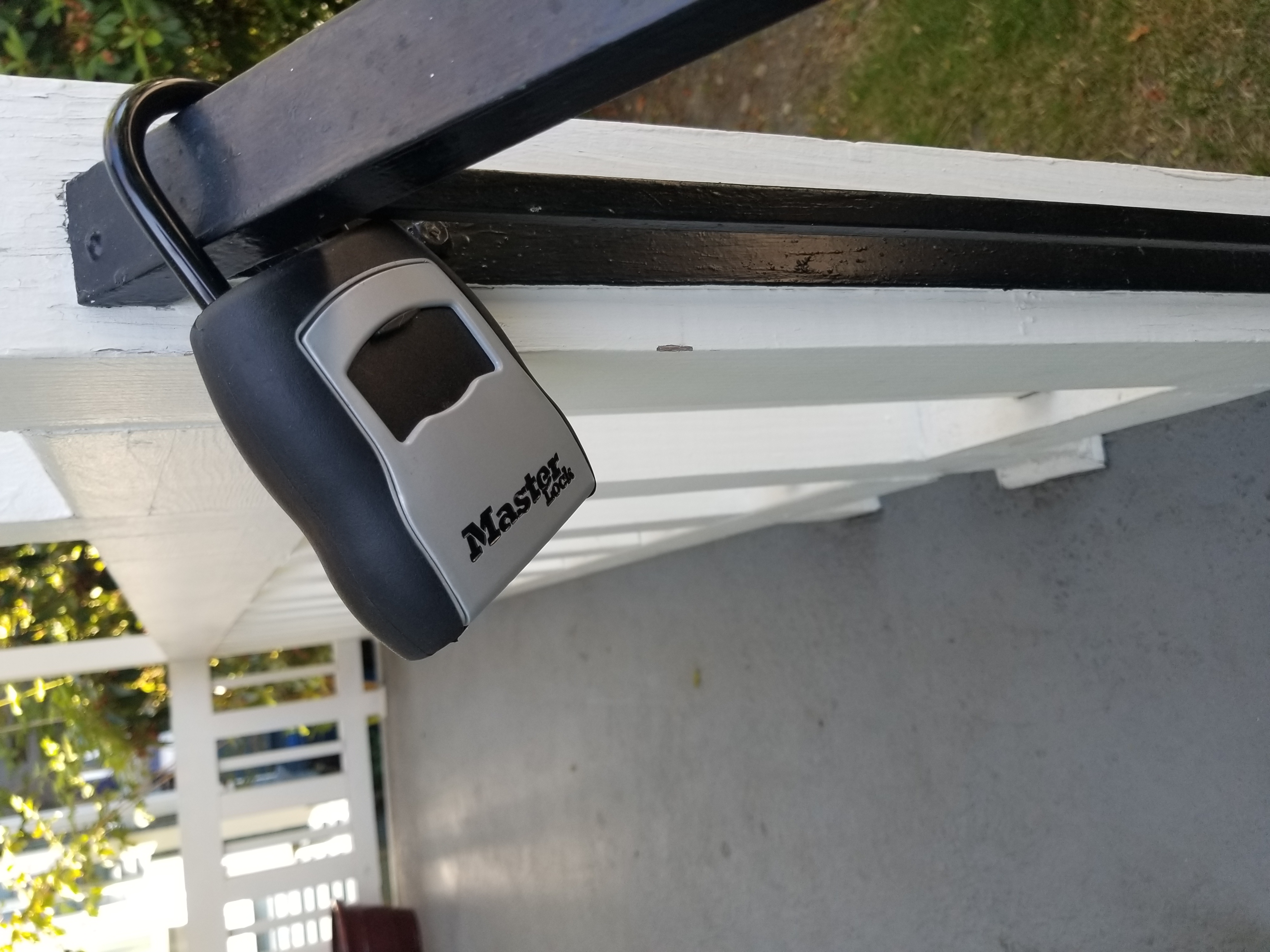
If you’re in the Seattle area and have one of these boxes, it might be time to retire it. They’ve figured out how to quickly break into this model. Contractor boxes of any model should be well secured to something solid, out of view from the road, and in place for as little time as possible.
Another quick note on these: if you’re sure you have the right code but it just won’t open, it may be overstuffed. Try squeezing it shut as you push the release switch.
Hardware for the Covid Times
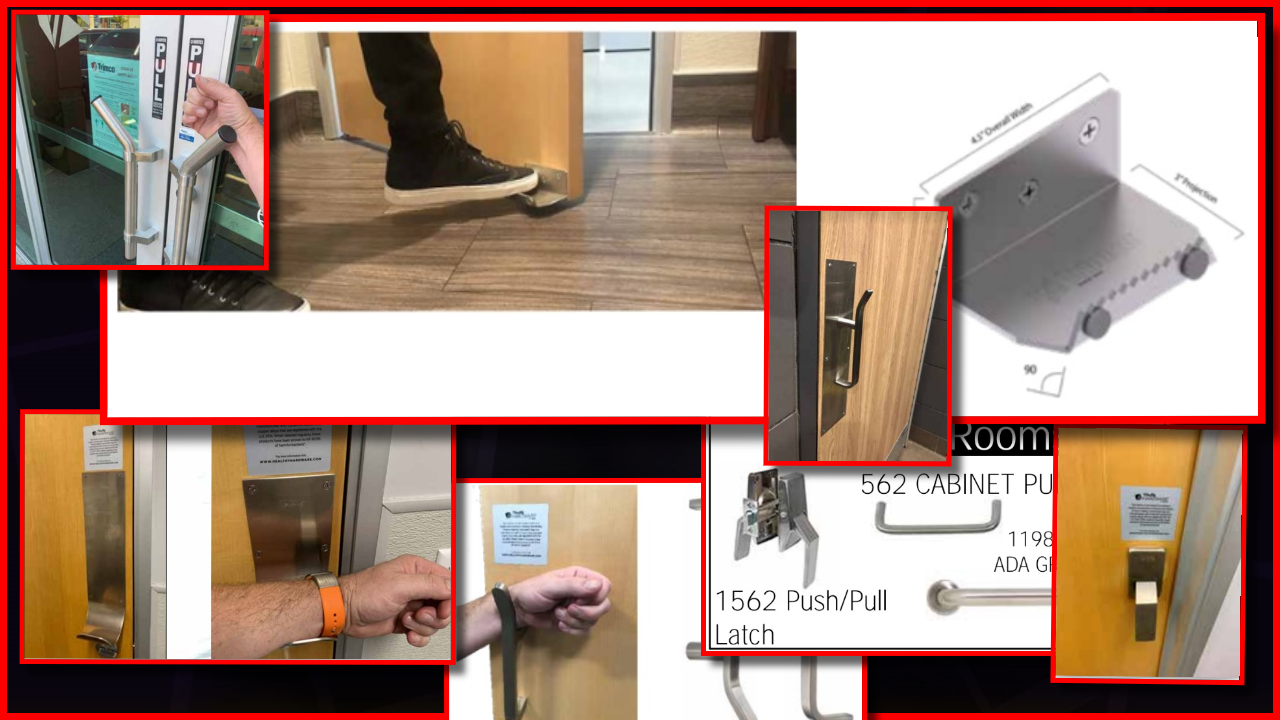
Today I received a promotional catalog from one of my hardware distributors with a bunch of door pulls that are designed to allow users to reduce their contact with door hardware in public spaces. These ones are made by Trimco. My favorite is the foot pull for the restroom door.
As a low-grade germaphobe, I WISH these had been popularized decades ago. Just this week I went into the bathroom of a Mexican restaurant to wash my hands before I ate my lunch and was horrified to find that it only had a hand dryer mounted to the wall. In normal times I might have waited for someone else to come into the restroom so I could awkwardly catch the door with my foot and slip out. But this place was only operating at 25% capacity and I knew I could be waiting for a long time. I don’t want to say how I got out of there, but let’s ust say I didn’t eat a single corn chip.
As a low-level germaphobe who is also a locksmith, I’ll be happy to recommend another qualified professional to get down on the floors of your public restrooms to install a set of these foot pulls.
MailBoss
Today I saw this row of mailboxes that had been plundered by a mail thief. Notice that the second and fifth boxes remain unscathed. They are produced by MailBoss, a Redmond-based company. I believe they make the most secure mailboxes on the market. They’re very difficult to pry open and the locks are hard to pick. I always groan when I show up to replace the lock on a mailbox with no keys and find that it’s a MailBoss mailbox.
These mailboxes are a little pricey compared to other products on the market, but in an area with as much mail theft as we have in and around Seattle, they’re well worth the cost. If you go into their warehouse in Redmond, you can usually score a store return for half price. But please don’t make the clerk open ten boxes in search of a perfectly unblemished mailbox. If you require perfection, new ones are available at many major retailers.
The model I like best is actually called the Mail Boss. It has a door that’s tilted inward when closed, so it’s especially hard to pry open. I believe both the boxes in this video are examples of the Mail Manager.
Hero Mother
Today a customer asked me to tell her the weirdest service call I’ve ever had. There are a lot of candidates, but this is the one that sprung to mind:
It was a hot August afternoon and a woman in southern Bellevue called me from her neighbor’s phone, saying she was locked out of her condo. I took down her address, quoted her a price and an ETA, and fired up my van.
When I arrived at the apartment complex I quickly located the right building and unit but did not find a stranded customer. I walked around for a few minutes and didn’t see her anywhere. Then I called the neighbor whose phone she had used to contact me in the first place. The neighbor came right out and recounted her interaction with the woman. She said, “Yeah, it was weird. She was limping and her arms were all scraped up. And she had two little dogs with her. I’ve never seen her before. I have no idea where she went.” I thanked her, did a sweeping scan of the complex one last time, and walked back to my van to get on with my day.
I was just pulling out of the parking lot when I saw an older woman sitting under a Japanese maple tree with a couple of dogs. I parked the van again and approached her. She gave me a look of happy recognition the moment she saw me. Up close, I could see that the dogs were a dachshund and a Chihuahua. She looked generally disheveled and she wasn’t wearing any shoes. And, like the neighbor said, her arms and legs had been bleeding. She looked kind of like a vagrant.
We introduced ourselves and she escorted me to her door. It was not the address she had given me over the phone, which I pointed out to her. “Oh,” she said. “I guess I misspoke.” I was suspicious. As is routine, I asked her for ID. She lifted her hands, palms to the sky, and told me it was inside. That’s not unusual. People don’t always make sure they have ID on them before they accidentally lock themselves out. But I was already a little dubious about the whole thing and wondering if I should just wish her well and move on. Instead I squinted at her like David Carradine playing the role of a Chinese monk in that old TV show, and thought to pepper her with one last round of questions. She broke pretty easily.
“Why did you get your own address wrong?”
“Well, it’s not really my place,” she said, as if she were confiding in me.
“What?! Then I can’t let you in!” I said, exasperated.
Immediately she realized her error. “Ohhh, nooo! You’ve gotta let me in! Pleeeeease let me in!” she begged.
“I can’t let you in to a property that’s not yours.”
“It’s my daughter’s place. I’m here dogsitting.”
“Where is she? Can we call her?”
“I don’t think so. She’s in Tahiti. And I don’t know her number. It’s in my phone, and my phone is inside.”
This was all plausible, but it didn’t explain why she looked like she’d just rolled out of a dumpster and then gotten into a fight with a bunch of alley cats, which then stole her shoes. I asked her what happened and she told me the story.
“Well, I went out on the balcony with the dogs and I didn’t realize that the sliding door would lock behind me when I shut it. It was really hot up there. It’s right in the sun and the floor was like a griddle. It was burning my feet. I was really afraid the dogs were going to overheat and die. I tried to use the propane tank from the grill to break the glass door but I couldn’t swing it hard enough. I was really scared for the dogs. I was calling for help but nobody came. Finally I dropped the dogs one by one into the bush below. Then I jumped into the bush too. That’s why I’m all cut up. My shoes are inside. Normally I have shoes.”
“Show me this balcony,” I said.
We went around to the back of the building, the dogs scampering along behind her, and she pointed up at a second-story balcony. Underneath it was a large hedge that looked like it had been split in half. I was convinced.
“Is your purse inside the unit?”
“Yes.”
“Do you have an ID in there?”
“Of course.”
“The first thing we’ll do when we get in is go to your purse and grab your ID.”
“Sure! Fine! No problem!”
I got the door open with little effort and the dogs bounded up the stairs inside the unit. My customer followed them up, limping the whole way. As if there was any remaining doubt, she got to the top of the stairs and pointed to her purse. Next to it was a tumbler filled to the middle with red wine. She pulled out her wallet, showed me her ID, and paid me.
“I hope your daughter appreciates you,” I told her before heading down the stairs and back to my van to get to the next job.
Schlage Encode
Schlage has introduced a new keypad lock that doesn’t require an intermediary hub to connect to your wifi. It’s called the Encode. Currently it’s available at Amazon and the big box stores for about $250. Smaller retailers can’t get their hands on it yet. I would wait at least until the end of 2019 before buying one so the manufacturers can work out the kinks, but I’m happy with what I’ve seen so far. The motor sounds healthier than the one found in Schlage’s Connect and Sense models. It also has a more compact design despite the increased functionality. And supposedly it is designed to integrate well with that creepy system that lets Amazon deliverymen walk into your house.
The only negative thing I’ve noticed about it so far is that the sticker with the random factory-assigned user codes is just under the battery cover. On other models this sticker is only accessible if you have a screwdriver; with this one, a visitor to your home could remove that battery cover and photograph the sticker in a matter of seconds. So if you buy this lock, make sure to move that sticker before putting it into commission. Otherwise, it looks like it will be a pretty good lock.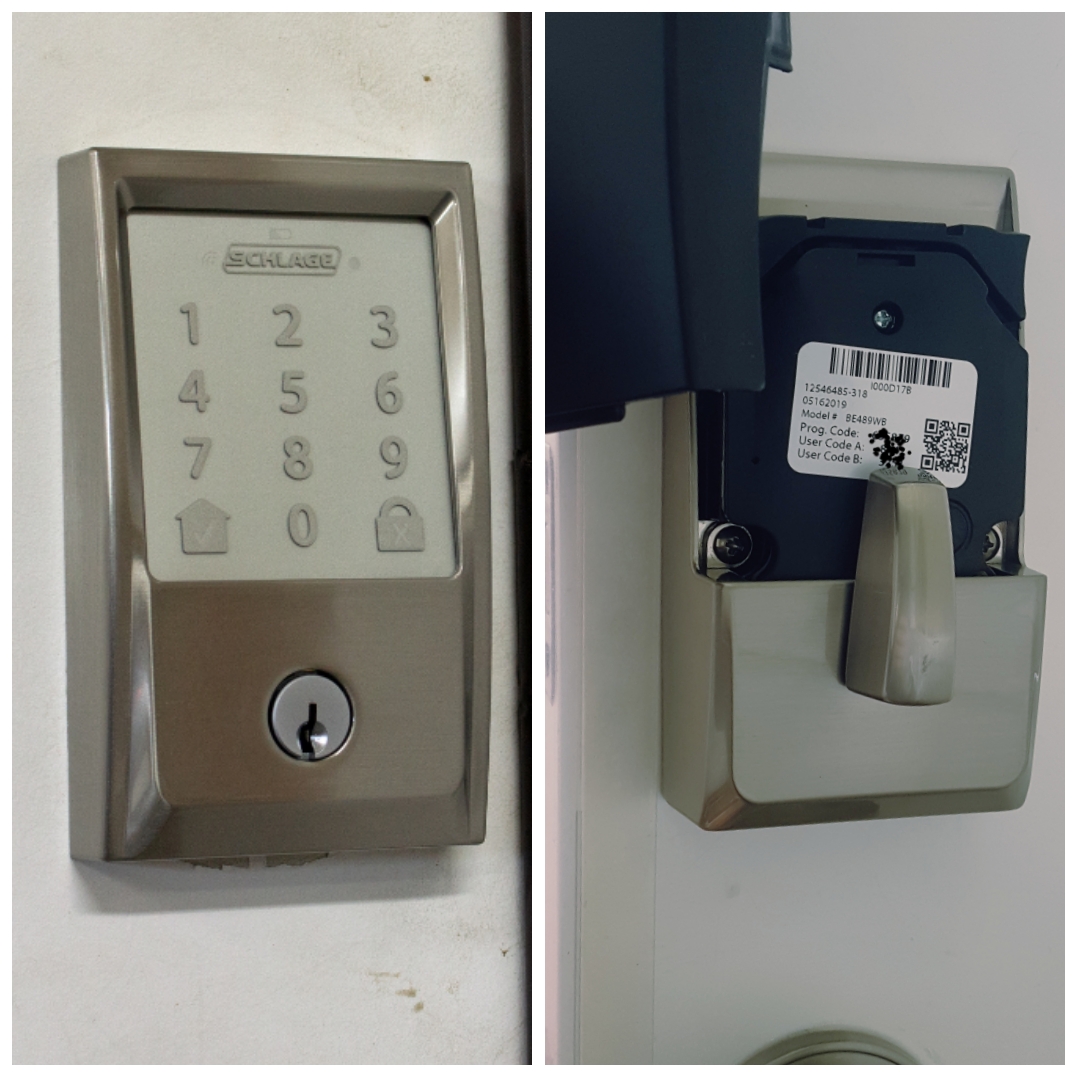
Locksmith Observation
Paranoia
 Last week a customer told me that strange things were happening and that his wife dismissed his concerns as paranoid. He recounted two recent incidents of people rifling through his car and gym locker without apparently stealing anything. In most cases I don’t dare tell a customer I think he is experiencing paranoid (or “persecutory”) delusions, especially when I’m pretty sure it’s the case. It can only lead to trouble. But this was a very smart immigrant working for a major software developer and it did not sound like he was describing a longstanding issue. I told him that if people close to him were suggesting he has paranoid delusions, he should be aware that it’s an actual diagnosable problem and should consider what they were telling him rather than allowing a small thing to become all-consuming.
Last week a customer told me that strange things were happening and that his wife dismissed his concerns as paranoid. He recounted two recent incidents of people rifling through his car and gym locker without apparently stealing anything. In most cases I don’t dare tell a customer I think he is experiencing paranoid (or “persecutory”) delusions, especially when I’m pretty sure it’s the case. It can only lead to trouble. But this was a very smart immigrant working for a major software developer and it did not sound like he was describing a longstanding issue. I told him that if people close to him were suggesting he has paranoid delusions, he should be aware that it’s an actual diagnosable problem and should consider what they were telling him rather than allowing a small thing to become all-consuming.
Once I arrived at a client’s apartment door for an appointment and had to knock, ring the doorbell, and call several times before he arrived at the door in a bathrobe. He apologized and explained that he’d been in the shower and didn’t hear the phone ring because of the radio. Indeed, it was blaring. I asked him to turn the stereo off so I could talk to him. He clomped over to his stereo to turn it down and then clomped back over to me. Then he dove into a long saga about how the girls in the apartment below him—recent college graduates—were terrible neighbors and had been harassing him relentlessly, breaking into his apartment and causing all kinds of mischief. As he told me this, he continued to stomp around the floor of his apartment. He was trying to drive the miscreants below to move away. They were the worst neighbors, he insisted. The previous week his surveillance camera had caught them skulking around inside his apartment while he was at work. Alas, he accidentally deleted the footage before he could turn it over to the police.
I had another client who sold her house and moved to a different city because she was fed up with her neighbors breaking into her home and stealing random items like car insurance bills, one shoe from a pair, and can openers. She’d spent a fortune having high-security locks installed on her exterior and interior doors, and then having them rekeyed over and over again. She would roam around her large unheated house with a passel of keys hanging from a lanyard around her neck, searching through them to find the right key to get into each room.
Another client was convinced that someone had broken into her house and left a glass in the sink. It was probably an ex-boyfriend, she thought. A different customer had just installed an expensive new lock but was convinced that her imaginary persecutors had tampered with it to make it slightly less resistant to lockpicking. Someone else called me to change her locks for the second time in a month because an electric blanket went missing from her bedroom closet.
There are certain commonalities in all of these cases. The imagined antagonists never seem to steal anything of value or do anything to threaten the health or livelihood of the victim. The violations all seem pointless. The subjects are normally employed with regular jobs, though some are a little eccentric and many tend to be hoarders. They often point to barely visible scratches on windowsills and doorframes as evidence of furtive entries. They usually have a clear idea of who the perpetrator is.
In all cases, they are genuinely suffering. It’s a devastating condition to have. People who imagine repeated victimization at the hands of mischievous home invaders feel the same range of terrible emotions that anyone does after a home is broken into. But they experience it over and over again. And what’s worse, the people closest to them don’t believe the stories and get tired of hearing about the problem. It can ruin relationships and leave people isolated from friends and family.
When I encounter these cases I try to come up with cost-conscious ways of making the customers feel more secure, but resist requests to repeatedly rekey their locks. I prefer to avoid customers who are experiencing paranoid delusions. If I were less scrupulous I might lick my chops at the fount of repeat business, but I’d much rather spend my time doing useful work than taking advantage of someone’s mental illness. Plus, I’m often concerned that a misstep could cause them to turn their suspicion toward me. More than anything, these customers make me feel kind of useless. Dozens of times throughout the week I’m presented with real issues that I’m able to completely resolve. This is one that I’m helpless to do anything about.
Satin Brass
For a few years I’ve been hearing people say that the next big trend in residential hardware will be the satin brass finish. The ubiquitous shiny brass finish fell out of favor years ago, largely replaced by satin nickel and aged bronze. Lately I’ve been seeing some new construction outfitted with shiny chrome door hardware. But just last month I noticed for the first time some satin brass offerings from Schlage on the shelves of the big box hardware stores. And I installed some last week. Along with this hardware they’re supplying the darker screws and latch plates that come with antique brass hardware, which is an interesting choice. I wonder if this will take off.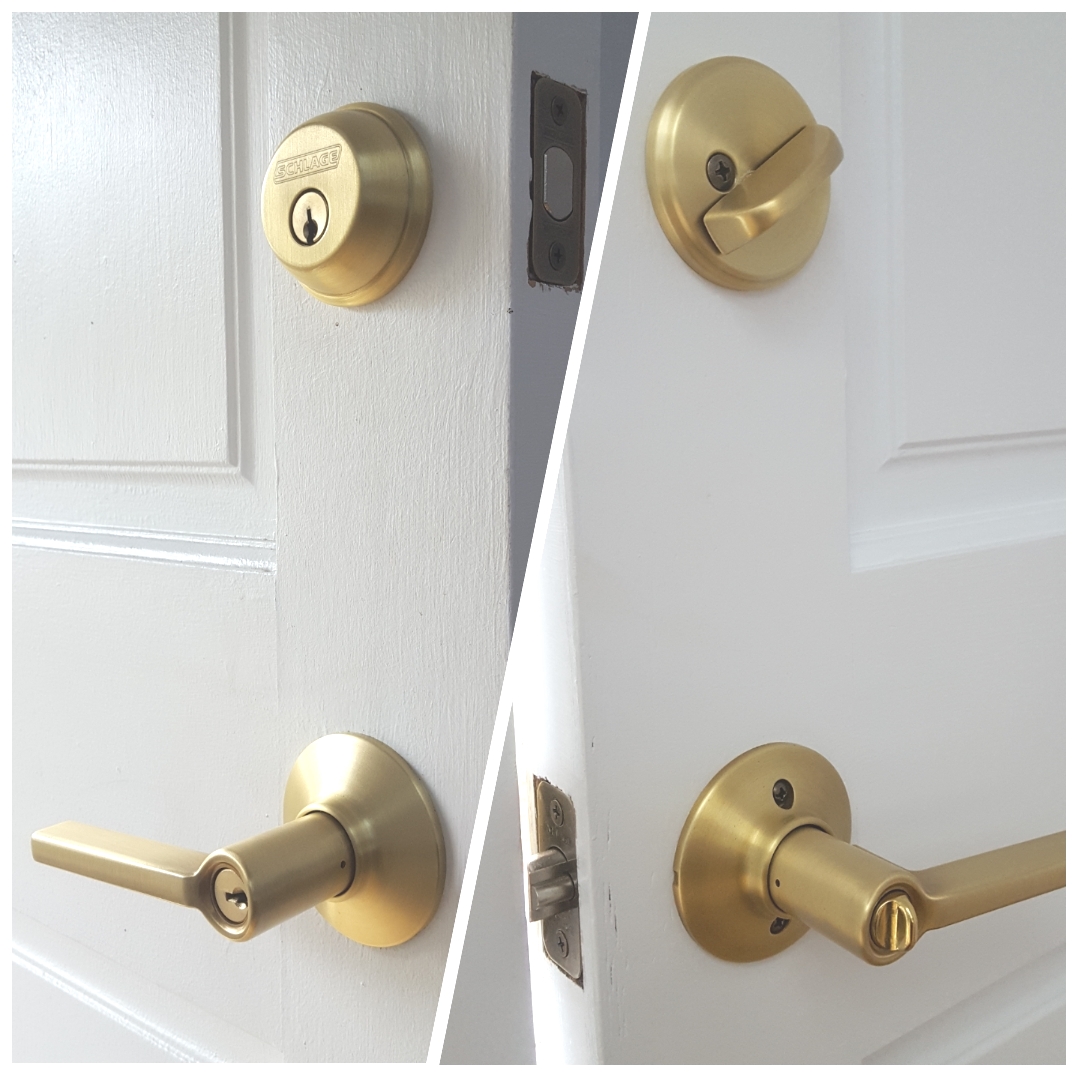
A Brief Note on Backset
Backset is a term related to the way a door i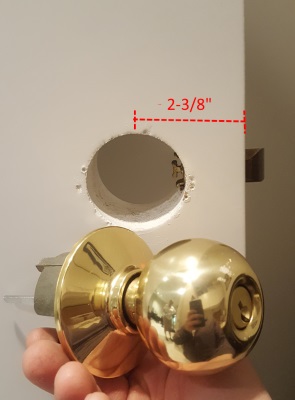 s prepped for lock installation. It refers to the distance between the edge of the door and the center of the door hardware. Most residential doors have a backset of 2-3/8” and most commercial doors use a slightly longer backset of 2-3/4”. These are not hardfast rules. Though some hardware is adjustable for either backset, it’s not always the case and sometimes you need to consider backset when ordering new locks.
s prepped for lock installation. It refers to the distance between the edge of the door and the center of the door hardware. Most residential doors have a backset of 2-3/8” and most commercial doors use a slightly longer backset of 2-3/4”. These are not hardfast rules. Though some hardware is adjustable for either backset, it’s not always the case and sometimes you need to consider backset when ordering new locks.
Back in the ‘60s and early ‘70s they thought it was cute to install locks with a 5” backset. Nowadays that creates a bit of a problem when the 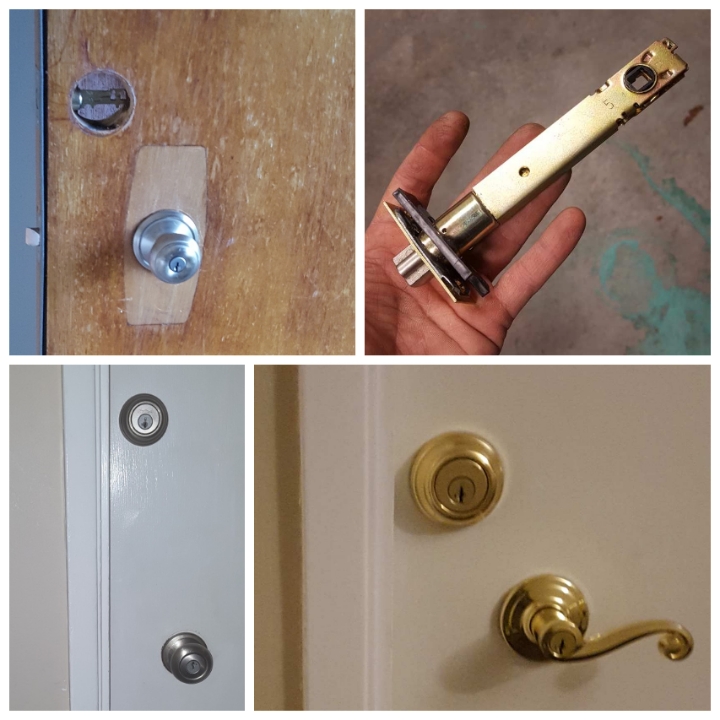 locks fail because you can’t just walk into Home Depot and buy a lock made for one of these oddly prepped doors from the 1960s. In those days, houses were rarely secured with anything more than locking doorknobs, so it also presents an issue when you want to add a deadbolt to the door. You have to decide whether to install a deadbolt that’s out of alignment with the knob, or to find one with an extended latchbolt. If you take the latter route it will always be a hassle to service or replace the lock. I usually advocate for the offset.
locks fail because you can’t just walk into Home Depot and buy a lock made for one of these oddly prepped doors from the 1960s. In those days, houses were rarely secured with anything more than locking doorknobs, so it also presents an issue when you want to add a deadbolt to the door. You have to decide whether to install a deadbolt that’s out of alignment with the knob, or to find one with an extended latchbolt. If you take the latter route it will always be a hassle to service or replace the lock. I usually advocate for the offset.
Here’s a case where someone decided to give up on looking for the specialty hardware. Instead he just installed a new deadbolt with a standard backset right next to the lock with the longer backset.
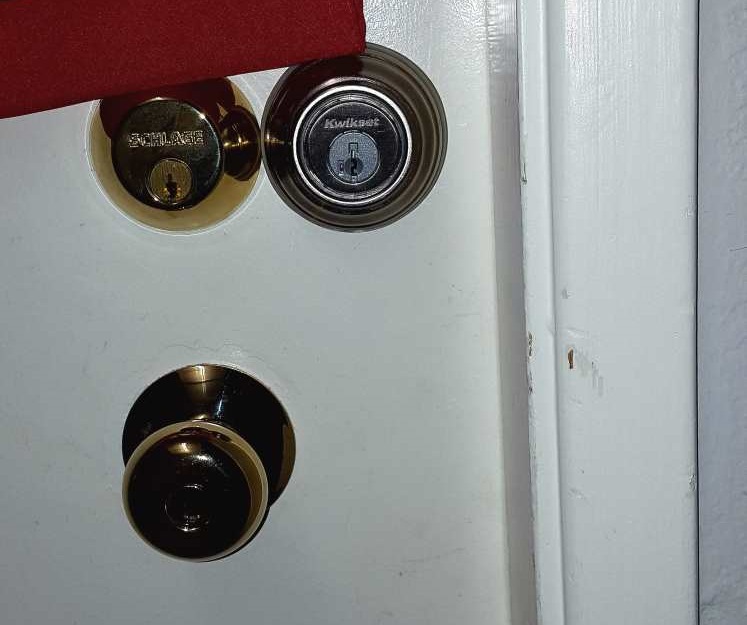

 Commercial
Commercial 

